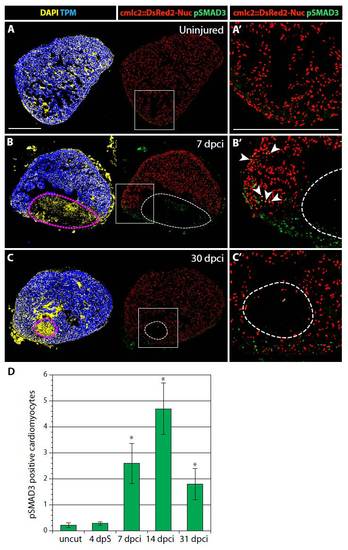Fig. S6
- ID
- ZDB-FIG-120601-25
- Publication
- Chablais et al., 2012 - The regenerative capacity of the zebrafish heart is dependent on TGFβ signaling
- Other Figures
- All Figure Page
- Back to All Figure Page
|
Alk5/4-dependent TGFβ/Activin signaling activates non-cardiac cells of the post-infarct and adjacent cardiomyocytes of the intact myocardium. (A-C′) Confocal images of heart sections from transgenic fish expressing nuclear DsRed2-Nuc (red) under the control of the cmlc2 cardiomyocyte-specific promoter. Immunostaining for Tropomyosin (TPM, blue) labels the myocardium and phospho-Smad3 (pSmad3, green) detects activation by Alk5/4-dependent TGFβ/Activin signaling. DAPI (yellow in the left panels) marks all the nuclei. Signal-activated cardiomyocytes are identified by the co-expression of DsRed2-Nuc and pSmad3. Dashed lines (B,C) denote the post-infarct. (A′-C′) Higher magnifications of the framed area in the corresponding left panels. (A,A′) In uninjured hearts, pSmad3 is not detected. (B,B′) At 7 dpci, numerous non-cardiac cells in the injury area contain pSmad3-positive nuclei. pSmad3 is also detected in a few cardiomyocytes in the vicinity of the post-infarct (arrowheads). (C,C′) At 30 dpci, when the heart is nearly regenerated, only a few pSmad3-positive cells remain around the injury area. (D) Quantification of pSmad3-positive cardiomyocytes. *P<0.05 compared with uncut, t-test; n=10; error bars indicate s.e.m. Scale bar: 300 μm. |

